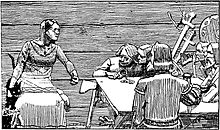Harald II (Norway)
Harald II. Gråfell († around 970 on the Limfjord ) was King of Norway from around 960 to 970.

He was the eldest son of Erik Blodøks and, according to the Historia Norwegiæ , by Gunnhild Gormsdottir , according to other sources by a Gunnhild from the same family in Trøndelag. When his father was expelled from Håkon the Good or by the people to England and died there in battle, he and his mother and brothers came to see Harald Blauzahn , King of Denmark, where he grew up. They were all given the title of king, and Gamle became the upper king. This was an army kingship , since they went mainly warlike on Viking journeys. Harald Blauzahn had long strived for supremacy over Norway. He pulled three times with the Erik sons and a large fleet against Håkon. He was beaten three times. In these battles Gamle and Guttorm fell. But the third time Håkon was fatally wounded in the Battle of Fitjar . Håkon had no heirs, so that the sons of Erik were no longer separated from the royal power. After Harald Blauzahn had paid homage in Tønsberg , he put Erik's sons as (taxable) sub-kings in Norway in 961, with Harald Gråfell receiving the most important part in the southwest and becoming upper king after Gamle. Harald Blauzahn immortalized this success in addition to paying homage to his parents on the Jellingstein .
In 962 Harald Gråfell and his brother Erling attacked the Ladejarl Sigurd Håkonsson , a son of Håkon, in Aglo in Stjørdal ( Trøndelag ) and burned him in his house. This incident led to long-term hostility between the Ladejarlen and the Harald Hårfagres family . With the delivery of the Sami, Trøndelag came under the rule of Harald Gråfell. He was the first king to control all shipping traffic on the west coast of Norway. This was also of great importance to Harald Blauzahn, because the trade in fur, walrus skin for high-quality ropes and walrus teeth was an important source of income for him. Harald's nickname is related to the fur trade he ruled. In 965 he made a trade expedition to the far north and is said to have reached the White Sea and the mouth of the Dvina . In any case, the fur trade from the Sami areas along the west coast increased by leaps and bounds. As his wealth increased, his dependence on Harald Blauzahn also decreased and with it his interest in further tribute payments to him.
The written sources report on the further very opaque. There must have been a lot of intrigue and slander. In 970 Harald II received a request from his uncle Harald Blauzahn to help him on a campaign against the Franks. Such a campaign was in the interests of both kings and so Harald Gråfell raised a large army and moved to Denmark. In Hals by the Limfjord he was ambushed by his uncle and murdered. So Harald Blauzahn regained control of all of Norway. He appointed the Ladejarl Håkon Sigurdsson , a son of Sigurd, who was murdered by Harald Gråfell, as his deputy in Norway.
There has been much speculation about Harald's nickname Gråfell. It has already been used in an anonymous, probably contemporary, skaldic tomb . Snorri Sturluson explained it with an anecdote according to which he had bought a fur coat from two Icelanders in Hardanger. Usually “Gråfell” refers to a sheepskin coat. More recently it has also been suggested that the name can be traced back to his trade in tobacco products in Northern Norway. "Gråverk" is the name for squirrel fur. This is based on a verse in the skald Geir Glumrason in the Gráfeldardrápa, according to which Harald fought against the Bjarmer on the Vina-bredden (Dvina bank). The assumption is that he came to the White Sea in Arkhangelsk . But that is hardly tenable, because it is said that they went east and not north. "Vina" often just means "river" in the Skald language. The Bjarmer, a Karelian people, were also to be found on Lake Ladoga .
Harald Gråfell is the last king who is believed to have descended from Harald Hårfagre .
literature
- Claus Krag: Harald 2 Eiriksson Gråfell. In: Store Norske Leksikon .
- Claus Krag: Vikingtid og rikssamling. 800–1130 (= Aschehougs Norges historie. Vol. 2). Aschehoug, Oslo 1995, ISBN 82-03-22015-0 .
See also
History of Norway from Harald Hårfagre to the unification of the empire
| predecessor | Office | successor |
|---|---|---|
| Håkon I. the good |
King of Norway 961–970 |
Harald Blue Tooth |
| personal data | |
|---|---|
| SURNAME | Harald II |
| ALTERNATIVE NAMES | Harald II Grafell |
| BRIEF DESCRIPTION | King of Norway |
| DATE OF BIRTH | 10th century |
| DATE OF DEATH | around 970 |